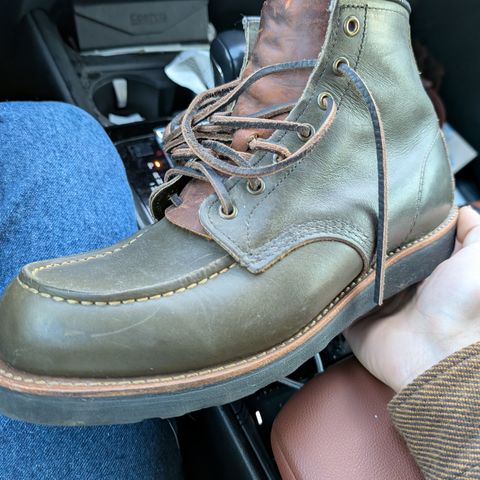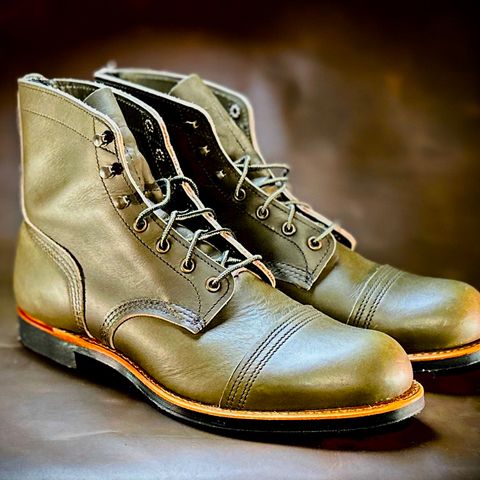About
Red Wing - S.B. Foot Alpine Portage is a deep green full-grain oil-tanned leather produced by S.B. Foot Tanning Company exclusively for Red Wing Heritage footwear. The leather's distinctive coloring is inspired by archive Kangatan leather that originally appeared on the Irish Setter Style no. 888 in 1954. As a color variation of S.B. Foot Portage leather, Alpine features the same chrome-tanned base with oil and wax conditioning that characterizes the Portage family, while offering a quiet, deep green aesthetic that evokes rugged outdoor heritage.
About
Red Wing - S.B. Foot Alpine Portage is a deep green full-grain oil-tanned leather produced by S.B. Foot Tanning Company exclusively for Red Wing Heritage footwear. The leather's distinctive coloring is inspired by archive Kangatan leather that originally appeared on the Irish Setter Style no. 888 in 1954. As a color variation of S.B. Foot Portage leather, Alpine features the same chrome-tanned base with oil and wax conditioning that characterizes the Portage family, while offering a quiet, deep green aesthetic that evokes rugged outdoor heritage.
Alpine Portage combines S.B. Foot's traditional oil-tanning processes with a historical color palette designed for outdoor performance. The leather undergoes wooden drum processing where steerhides soak in specialty tree oils, tanning agents, and green dyes, creating a water-resistant heavyweight utility leather with distinctive visual character. Currently featured on Red Wing Heritage models including the 8078 Iron Ranger and 8828 Classic Moc, Alpine Portage represents the brand's commitment to reviving historical colorways in modern premium leather formulations.
Historical origins
The Alpine Portage colorway traces its heritage to 1954, when Red Wing introduced the Irish Setter Style no. 888 featuring deep green Kangatan leather. This original leather was developed for rugged outdoor trails during an era when Red Wing emphasized performance characteristics for hunters and outdoor workers. The deep green coloring provided practical camouflage benefits while demonstrating leather's capability to hold rich, saturated dyes that would age distinctively through field use.
The original Kangatan leather represented a different tanning approach than the modern Portage formulation, but the color concept proved enduring enough to warrant revival decades later. When Red Wing Heritage began exploring archive colors for contemporary releases, the 1954 deep green emerged as a candidate for reinterpretation using S.B. Foot's modern oil-tanned Portage leather platform.
The revival of Alpine Portage as a modern colorway involved collaboration between Red Wing's product development team and S.B. Foot Tanning Company, leveraging over a century of combined tanning knowledge to recreate the archive green using contemporary oil-tanning methodology. The resulting Alpine Portage maintains the deep green aesthetic of the 1954 original while incorporating the performance characteristics—water resistance, durability, and low maintenance—that define the Portage leather family. This heritage revival approach aligns with Red Wing Heritage's strategy of connecting historical products with modern manufacturing capabilities.
Specifications and characteristics
Alpine Portage shares the fundamental specifications of the Portage leather family, produced from full-grain steerhides in weights of 5 to 6 ounces (2.0 to 2.4 millimeters) with medium temper suitable for footwear construction. The leather features a semi-aniline finish that preserves natural grain patterns while providing surface protection and color consistency. As a second-run grade leather, Alpine Portage may exhibit minor cosmetic imperfections including small scars or scratches that do not affect structural integrity but contribute to the leather's authentic character.
The chrome-tanned base provides the dimensional stability and flexibility essential for footwear applications, while subsequent oil and wax conditioning creates the characteristic greasy, conditioned feel common to all Portage variations. This combination tanning approach results in leather that resists water, stains, and perspiration more effectively than purely vegetable-tanned alternatives. The oil and wax blend penetrates deep into the leather fibers during extended drum processing, producing the distinctive deep green coloration and a surface that naturally conceals scuffs through the leather's inherent oils.
The defining characteristic of Alpine Portage is its quiet, deep green color that distinguishes it from other Portage variations such as Amber and Oro Russet. The green dye penetrates thoroughly during the oil-tanning process, creating consistent coloration throughout the leather thickness rather than relying solely on surface pigmentation. This depth of color contributes to Alpine's ability to maintain its distinctive green appearance even as the leather develops patina through wear. The smooth surface exhibits minimal texture variation with a slightly waxy hand feel, and the matte finish shows the consistent deep green coloring that evokes outdoor and military heritage aesthetics.
Alpine Portage exhibits the same water resistance and self-healing properties characteristic of oil-tanned leathers. The higher oil content provides weather protection suitable for outdoor use while allowing the leather to heal minor scuffs as oils migrate within the leather structure. The deep green coloration proves particularly distinctive in the heritage footwear market, where brown and tan tones dominate, making Alpine a sought-after option for collectors and enthusiasts seeking unique colorways with historical authenticity.
Production process
Alpine Portage production follows S.B. Foot Tanning Company's established oil-tanning methodology, beginning with steerhides that arrive as "wet blues"—pre-processed chrome-tanned leather from regional tanneries within a 600-mile radius of Red Wing, Minnesota. This chrome-tanned foundation provides the structure, flexibility, and dimensional stability that forms the base for all Portage variations, including Alpine.
Selected hides undergo thickness evaluation and grading before entering the conditioning phase specific to Alpine's deep green color. The leather is placed into traditional oak wooden drums where it soaks in a float of tree oils distilled from bark and vegetation, along with tanning agents and the green dyes that create Alpine's distinctive coloring. The drum rotation allows these materials to penetrate deep into the leather fibers over extended processing periods, with wooden drums preferred over steel for their heat-absorbing properties that ensure consistent processing conditions and color development.
The oil and wax stuffing process distinguishes Alpine Portage from standard chrome-tanned leathers. The blend of oils, waxes, and green dyes saturates the leather thoroughly, creating both the characteristic greasy feel and the deep green coloration that defines Alpine. Extended barrel spinning time allows dyes and oils maximum penetration, with hides processed until the conditioning materials fully saturate throughout the leather thickness. This extended conditioning creates Alpine's ability to heal scuffs naturally while maintaining color consistency as the oils migrate within the leather structure.
Following initial drum processing, the leather undergoes vacuum drying to reduce moisture content to approximately 25 percent. Finishing operations including staking, additional oiling if required, and surface treatments prepare the leather for cutting and use. The green dye integration during the oil-tanning process means that Alpine's color penetrates throughout the leather rather than existing only as surface pigmentation, contributing to color consistency and longevity even as the leather develops patina through wear.
Applications
Alpine Portage finds primary application in Red Wing Heritage footwear, where the distinctive deep green coloring provides a heritage aesthetic distinct from the brown and tan tones typical of work boot leather. The leather appears on the 8078 Iron Ranger, a 6-inch service boot that represents Red Wing's iconic heritage work boot silhouette. The Iron Ranger construction utilizes Goodyear Welt methodology with Vibram lugged outsoles, pairing Alpine's smooth oil-tanned finish with rugged outdoor functionality.
Alpine Portage also features on the 8828 Classic Moc, a 6-inch boot with moc toe construction that traces its heritage to 1954—the same year as the original green Irish Setter Style no. 888 that inspired the Alpine colorway. The Classic Moc pairs Alpine's deep green leather with Red Wing's wedge outsole construction, creating a versatile boot suitable for both work and casual applications. The historical connection between the 8828 Classic Moc design and the 1954 original that inspired Alpine's color creates thematic consistency in the product offering.
The 5-6 ounce weight of Alpine Portage provides sufficient structure for boot uppers while maintaining the flexibility necessary for break-in and long-term comfort. The oil-tanned characteristics make Alpine suitable for Goodyear Welt construction, where the leather must withstand stitching and lasting processes while maintaining dimensional stability. The water resistance inherent to Portage leather makes Alpine appropriate for outdoor use and work environments where moisture exposure occurs regularly.
While Alpine Portage is produced exclusively for Red Wing Heritage and does not appear to be available as bulk leather for general leather craft applications, the specifications would theoretically suit outdoor leather goods including straps, bags, and equipment where the distinctive green color and water resistance provide both aesthetic and functional benefits. The semi-aniline finish accepts limited tooling, though the oil content may affect detail retention compared to vegetable-tanned leathers optimized for carving. The primary market focus remains Red Wing Heritage footwear, where Alpine serves enthusiasts seeking distinctive colorways with historical authenticity and premium S.B. Foot construction quality.
Care and aging
Alpine Portage requires minimal conditioning due to its oil-tanned nature, as the leather retains significant oil content from manufacturing that persists throughout the leather's service life. Light cleaning with damp cloth or foam cleaner removes surface dirt and salt without stripping the conditioning oils that provide Alpine's characteristic performance. The deep green color proves more delicate than browns and tans in terms of conditioning product selection—leather cream represents the preferred conditioning product when treatment becomes necessary, as it nourishes the leather without substantially altering the distinctive green color or masking natural patina development.
Over-conditioning should be avoided with Alpine Portage, as excessive oil application can darken the green color and interfere with the leather's natural aging progression. The oil-tanned base means that Alpine already contains abundant conditioning from production, requiring only periodic treatment when the leather shows dryness after extended exposure to harsh conditions. Leather protector spray products provide additional weather resistance without affecting color, applied from 6-8 inches in sweeping motions to create an invisible moisture barrier.
Alpine Portage ages through natural wear and exposure, developing character that reflects individual use patterns while maintaining its distinctive deep green coloring. High-flex areas such as vamp creases and ankle bends show the most pronounced wear patterns, with the oil content allowing the leather to maintain flexibility and resist cracking even as distinctive creasing develops. Unlike Oro Russet Portage, which develops warm patina tones, Alpine maintains its deep green base while developing subtle tone variations that enhance rather than obscure the color.
The leather's full-grain nature means that natural marks including small scars and grain variations present from production become more visible with age, creating unique patterns that distinguish each piece. The second-run grade designation reflects the presence of these natural characteristics rather than structural deficiencies, with the cosmetic variations contributing to Alpine's distinctive aesthetic appeal. The smooth oil-tanned finish develops a worn appearance in high-contact areas, creating visual depth and demonstrating the leather's authentic aging characteristics valued by heritage footwear enthusiasts.
Initial color transfer may occur during the first several weeks of wear as excess surface oils work out of the leather and stabilize, though this crocking diminishes significantly over time as the leather's oil content equilibrates. The deep green dye integration throughout the leather thickness means that color remains consistent even as surface wear occurs, avoiding the faded appearance that can affect surface-pigmented leathers. Avoiding chemical cleaners and harsh treatments preserves Alpine's characteristic matte finish and allows natural patina evolution that enhances the leather's heritage character while maintaining the distinctive deep green coloring that defines this historical colorway.
References
"Reviving Rich Greens from 1954: The Alpine Portage Classic Moc". Red Wing Shoe Company. Retrieved October 14, 2025.
"Men's Iron Ranger 6-Inch Boot in Alpine Portage Leather 8078". Red Wing Heritage. Retrieved October 14, 2025.
"Men's Classic Moc in Alpine Portage Leather 8828". Red Wing Heritage. Retrieved October 14, 2025.
"Portage - Amber". Maverick Leather Company. Retrieved October 14, 2025.
"Leathers". S.B. Foot Tanning Company. Retrieved October 14, 2025.



































































